Love and Torture in Conor McPherson’s The Dance of Death
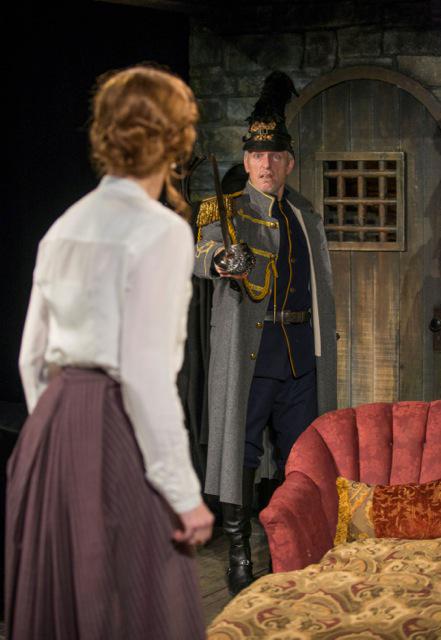
Just in time for wedding season, Henry Wishcamper’s taut staging of Conor McPherson’s new version of August Strindberg’s The Dance of Death takes a dystopian look at love everlasting. Produced by Writers Theatre in suburban Glencoe, Illinois, it played April 1-July 20. The Dance of Death is, famously, about a supremely unhappily married couple, the embodiment of Sartre’s pithy quote, “Hell is other people.” Sartre wrote No Exit in 1944, a generation after Dance of Death was first published in 1901. McPherson’s adaptation is perhaps a testament to the lasting influence of Strindberg’s representation of existential anguish.
Edgar (Bill Bannon went on for Larry Yando) and Alice (Shannon Cochran) sit in their suffocating apartment (designed by Kevin Depinet) listening to music (composed by Josh Schmidt) waft through their tiny windows from the party they have not been invited to play from across the street.
Pleasure. I’ve forgotten what that is.
Don’t ask me to describe it to you.
Soon this will be all over! We’ll be dead!
The hopeful thing Edgar and Alice look forward to is that their “corpses may fertilize the cabbages.” They sit together in abject misery, locked together forever in a prison of their own making as they wait to die.
As I sat in Writers Theatre’s intimate thirty-five-seat performance space at the back of a bookstore, I watched a sold-out audience of baby boomers ingest the nihilist battle onstage with rapt attention. Wishcamper’s alley staging gave me a clear view of patrons roughly the same age and perhaps life stage as the characters, and this double reality made me keenly aware of the play’s theme of aging.
Alice and Edgar are coming up on their twenty-fifth wedding anniversary and their lives have not turned out as they might have hoped or expected; they have spent two and a half decades punishing each other, locked in a macabre game of their own making.
Alice is always beautifully dressed (in costumes by Rachel Laritz), although she has nowhere to go and no one to see. A former actress Edgar “rescued” from the stage, she bemoans how all the people she started out with are famous while she is barely scraping by in their isolated, island prison of a home. Edgar is sick with a “calcification of the heart” and though he insists “I’ll be happy the day I drop dead,” when he does indeed fall ill, the heavy wooden door swings open, the wind rattles the window, and Edgar sees across the veil of the living. “I’m not ready to die,” he insists to the invisible apparition—though he does not follow his doctor’s advice to give up drinking, smoking, and working.
Through the first act, the torturous marriage seems to be mostly Edgar’s fault. He has isolated Alice from friends and family, alienated his superior officers, and failed to build a career that could provide material comfort for his family. He is a pretentious blowhard, and though Alice is no wilting flower, he’s a drunk, and a bully, and he gives it better than he can take it.
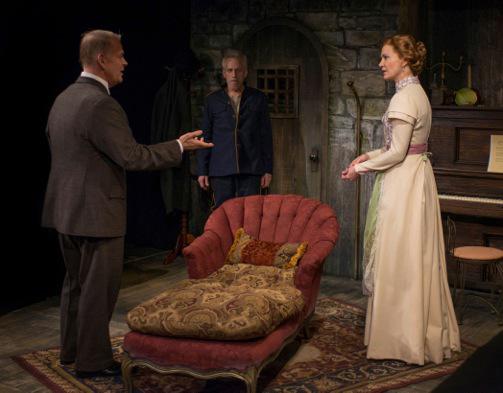
Photo by Michael Brosilow
In the second act, the tables turn, and we see just how manipulative Alice can be. She seduces her cousin Kurt (Philip Earl Johnson), who appears through the first act to be a rather reasonable and steady witness to the madness of the marriage. Alice enacts a complex plan to have Edgar arrested and out of her life for good. Kurt digs his teeth into Alice’s neck, coming up with blood on his lips. Alice grins in triumph at his transformation into a “wild beast.” As we watch her twist and turn her new lover, Alice’s role in creating her torturous marriage becomes more and more apparent. Edgar and Alice are both horrible people, and in this horror, it appears they are perfectly matched.
Divorce wasn’t unheard of in Strindberg’s time; approximately eight percent of marriages ended in divorce around the start of the twentieth century, as opposed to the often-quoted statistic of a fifty percent divorce rate in the twenty-first. Strindberg, himself, married and divorced twice before writing The Dance of Death. Edgar and Alice may each threaten divorce, but they do not choose to take action.
They have made a marriage in which they cannot show each other love, kindness, or tenderness. However, we see in their fleeting moments of laughter and joy, that together Alice and Edgar are united against the rest of the world.
Despite their self-imposed misery, Edgar and Alice do love each other. It leaks through in moments when the other isn’t watching. Alice tucks Edgar in when he falls ill. Edgar caresses Alice’s photograph in her absence. Each immediately recovers from any moment of vulnerability with a precision attack. They have made a marriage in which they cannot show each other love, kindness, or tenderness. However, we see in their fleeting moments of laughter and joy, that together Alice and Edgar are united against the rest of the world. They may hate each other, but they hate everyone else more. They deserve each other and their homemade hell, and they are able to recognize it. While the production ends with no hope that their marriage will change—Edgar won’t die soon enough, they won’t divorce, and their dance will continue—it does leave the audience with a sense that their relationship isn’t quite as bleak as it first appears.


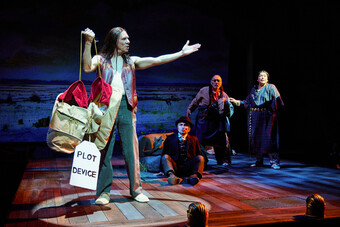

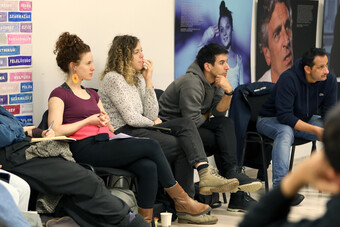


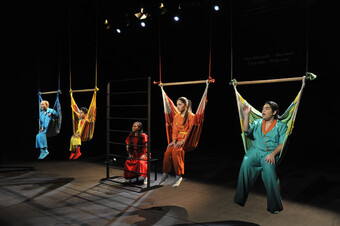


Comments
The article is just the start of the conversation—we want to know what you think about this subject, too! HowlRound is a space for knowledge-sharing, and we welcome spirited, thoughtful, and on-topic dialogue. Find our full comments policy here